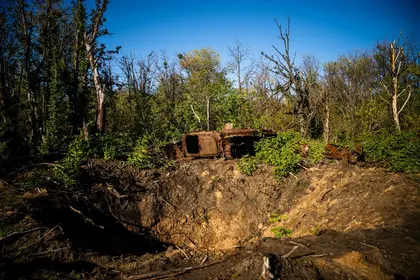We often hear about the damage Russia has caused to Ukrainian infrastructure or residential buildings. Ecology is rarely talked about, but today nature suffers no less than the people who live in it.
According to the state website EcoZagroza, Russia has caused enormous losses to Ukraine. In particular, would have to compensate almost Hr.987 billion ($27 billion) for damage to air alone. If we are talking about the soil, then the amount of damages is Hr.843 billion ($23 billion). However, according to ecologists, the real damage significantly exceeds these figures, and it is impossible to calculate them.
JOIN US ON TELEGRAM
Follow our coverage of the war on the @Kyivpost_official.
As Oleksiy Vasyliuk, head of the Ukrainian Nature Conservation Group, explained to Kyiv Post, this is unrealistic, as it is not just some territory or part of nature that is being destroyed, but the entire ecosystem.
“An ecosystem is not just some number of living organisms or some area. It is a system of connections,” he explained.
“If a rocket lands on a certain territory, a rare species of some plant may disappear. And this is not the last stage. Because poisonous plants will later appear in their place.”
As another example, Vasyliuk evoked a field of bomb funnels and craters on the outskirts of Izyum, in the Kharkiv region. “How do we calculate the damage if we do not know how it was before the war? How many types of plants were there?” he asked

EU Transfers €1.5 Bln Raised From Russian Assets for Ukraine
Vasyliuk said that the figures given on the EkoZagroza website are more about calculating losses for the state, not for nature.
“When a forest burns, the loss of trees is calculated, but the forest is also about rare plants. And about animals. And in general, how can you estimate how much the life of this or that creature is worth?” he said.
In addition, he pointed out that these figures are very approximate, since a large part of Ukraine is still occupied. And there are still parts of the country that cannot be accessed.
As an example, the ecologist cited the Kamiani Mohyly Nature Reserve in the occupied Donetsk region, where several species of rare plants grow. According to Vasyliuk, today it is not known for certain whether these species still exist or not, since there is no way for environmentalists to check.
Alien plant invasion and rocket pollution
Today, one-fifth of Ukraine is mined. It is clear that there is no activity in this area. Moreover, 33 percent of Ukrainian fields that were previously cultivated and sown are located on this territory. Today, this area is an ideal springboard for dangerous alien plants. It should be understood that even after the victory, even after demining (which will take tens of years), it will not be possible to grow anything on this land for a very long time.
One of the biggest threats not only to the population of Ukraine, but also to the entire ecosystem is rockets. During flight, they emit nitrogen, water vapor, carbon monoxide, carbon dioxide and brown gasses. Also, the rocket flight destroys the corridors of migratory birds.
In addition, Russian missiles sometimes hit critical infrastructure, such as oil depots or factories full of chemical substances. All this gets into the atmosphere, water and soil.
And, of course, rockets and projectiles that hit all over the territory of Ukraine cause damage at the site of impact. During the explosion, iron, copper and sulfur are emitted. It can take years, sometimes decades, for the soil on which the projectile explodes to recover. As a result, environmentalists forbid the use of an area after an explosion.
As for mined territories, at least 200,000 square kilometers of land will need to be demined in Ukraine. And most of this territory, as we mentioned above, will not be suitable for agricultural work.
Then there is the issue of fires that often start after being hit. Rescuers do not always have the opportunity to extinguish them. As such, in 2022, the number of forest fires increased tenfold. According to the Ministry of Environment, as of today, approximately 3 million hectares of Ukrainian forests have seen combat, and almost 30 thousand hectares have been burned. In addition to the release of harmful substances into the air, the entire ecosystem is destroyed: plants, animal habitats, and the animals themselves.
Another significant problem is related to water resources. Because of the war in Ukraine in 2022, more and more dried up bodies of water have appeared on the map – as well as the contrary.
Dams have been blown up, fields flooded. In this case, the soil suffers, as well as those living organisms that lived on this territory. We should also not forget how much bodies of water have been affected by chemical contamination during the year since the full-scale invasion.
Since nearly all military actions harm the environment, the damage will continue indefinitely. And it is worth noting that it will not be limited to Ukraine, especially when it comes to the air – ever reminding us again that our planet was not created for war.
You can also highlight the text and press Ctrl + Enter






